Business Environment Analysis and PESTEL of Royal Bank of Scotland PLC
VerifiedAdded on 2022/12/23
|12
|3437
|1
Report
AI Summary
This report offers a comprehensive analysis of the Royal Bank of Scotland (RBS) PLC, examining its governance structure, including the roles of key executives and directors, and its hierarchical organizational structure. It then delves into the importance of PESTEL analysis for organizations, highlighting its role in identifying significant changes, strategic planning, product development, personnel planning, and understanding market needs. The core of the report applies the PESTEL framework to analyze the external environment of RBS PLC, evaluating the impact of political, economic, social, technological, environmental, and legal factors on the bank's operations. The analysis indicates both positive and negative impacts of these factors, providing insights into the bank's global operations and its responses to external pressures. The report concludes with a summary of the key findings and implications for RBS PLC.

Royal Bank of
Scotland PLC
Scotland PLC
Paraphrase This Document
Need a fresh take? Get an instant paraphrase of this document with our AI Paraphraser

Executive Summery
This report states the factors which influence any business, either it can be externally or
internally, commonly known as Business Environment. It is necessary for every business
organisation to analyse these factors for giving directions for growth, continuous learning, image
building,meeting competition etc. Royal Bank of Scotland which is a huge commercial and retail
bank of UK. PESTEL is a tool used by various organisations to make understandable external
factors of business. It is a cost effective tool which provide deeper understanding, develop
alertness and exploit opportunities. PESTEL analysis of Royal Bank of Scotland shows that they
have a good opportunity by political factors to grow their business globally. Through economic
factors, it is found that globalisation is very risky for them because of different economic
condition of countries. Also they had made a positive or good impacts towards society as they
donated approx 7 billion pounds to the society. PESTEL of RBS shows that Political, Social and
legal business factors implies a positive impact on the business while Economic, technological
and environmental factors implies negative impact.
This report states the factors which influence any business, either it can be externally or
internally, commonly known as Business Environment. It is necessary for every business
organisation to analyse these factors for giving directions for growth, continuous learning, image
building,meeting competition etc. Royal Bank of Scotland which is a huge commercial and retail
bank of UK. PESTEL is a tool used by various organisations to make understandable external
factors of business. It is a cost effective tool which provide deeper understanding, develop
alertness and exploit opportunities. PESTEL analysis of Royal Bank of Scotland shows that they
have a good opportunity by political factors to grow their business globally. Through economic
factors, it is found that globalisation is very risky for them because of different economic
condition of countries. Also they had made a positive or good impacts towards society as they
donated approx 7 billion pounds to the society. PESTEL of RBS shows that Political, Social and
legal business factors implies a positive impact on the business while Economic, technological
and environmental factors implies negative impact.
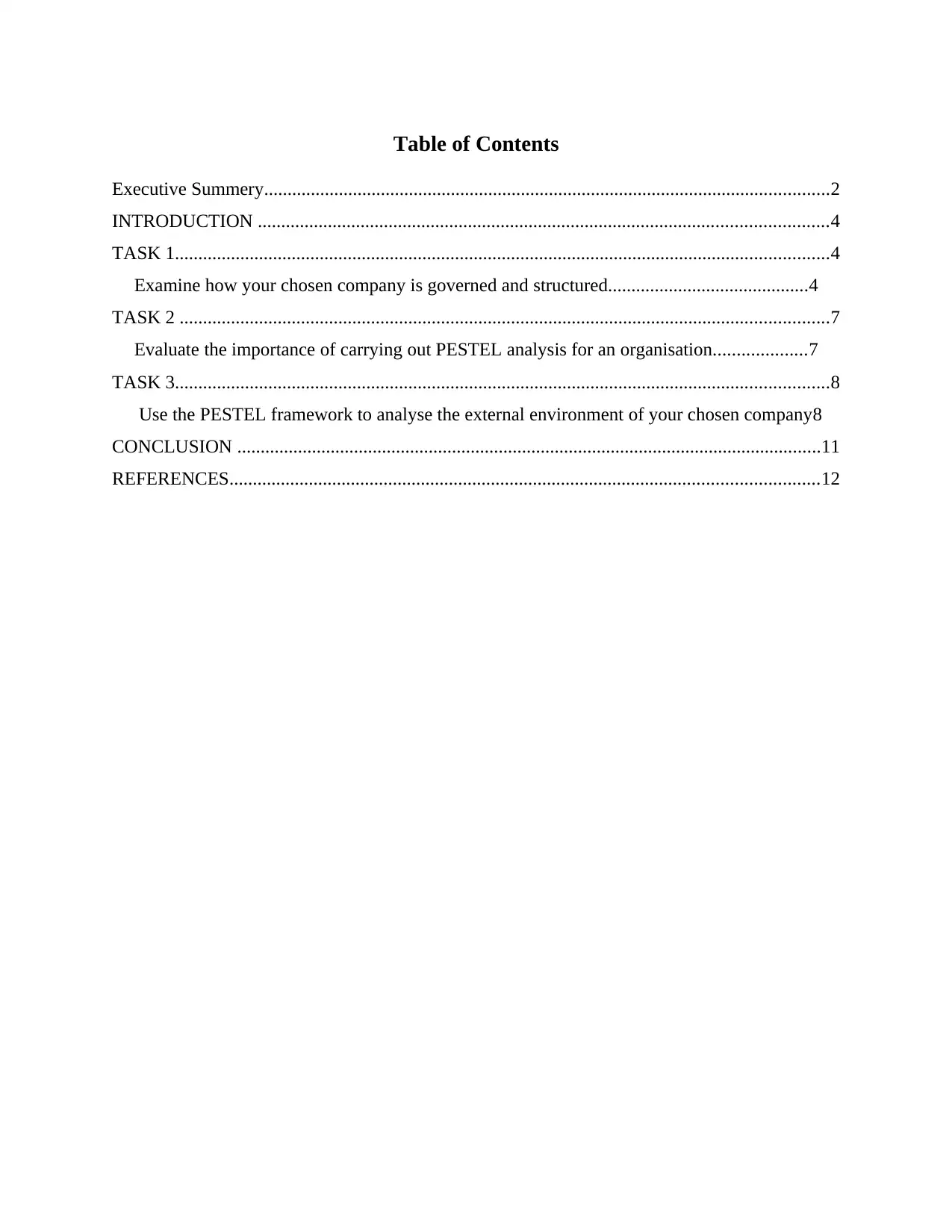
Table of Contents
Executive Summery.........................................................................................................................2
INTRODUCTION ..........................................................................................................................4
TASK 1............................................................................................................................................4
Examine how your chosen company is governed and structured...........................................4
TASK 2 ...........................................................................................................................................7
Evaluate the importance of carrying out PESTEL analysis for an organisation....................7
TASK 3............................................................................................................................................8
Use the PESTEL framework to analyse the external environment of your chosen company8
CONCLUSION .............................................................................................................................11
REFERENCES..............................................................................................................................12
Executive Summery.........................................................................................................................2
INTRODUCTION ..........................................................................................................................4
TASK 1............................................................................................................................................4
Examine how your chosen company is governed and structured...........................................4
TASK 2 ...........................................................................................................................................7
Evaluate the importance of carrying out PESTEL analysis for an organisation....................7
TASK 3............................................................................................................................................8
Use the PESTEL framework to analyse the external environment of your chosen company8
CONCLUSION .............................................................................................................................11
REFERENCES..............................................................................................................................12
⊘ This is a preview!⊘
Do you want full access?
Subscribe today to unlock all pages.

Trusted by 1+ million students worldwide

INTRODUCTION
Business Environment is the collection of those factors which implies some effect on the
business. It include both external and internal factors. It is mandatory for all business to do their
operations according to the business environment. Doing work by taking in mind about the
business environmental factors can provide a lots of opportunities to the organisation otherwise it
will result in huge losses. All the business have various factors as the business environmental
factors are totally depend on the nature of business, size of business etc. It is found that the
business environment is divided into two categories. First one is Internal Business Environment
and second one is External Business Environment. This report will include the overview, history,
chairperson, directors of Royal Bank of Scotland PLC. It also include the PESTEL Analysis of
Royal Bank of Scotland PLC which explain about the external factors i.e. Political, economical,
social, technological, environmental and legal factors influencing the Bank in various methods.
TASK 1
Examine how your chosen company is governed and structured.
The Royal Bank of Scotland is an international retail company of banking and financial
industry which was established in 1724. It's headquarters are in Edinburgh, Scotland, UK. It is
examined that around 700 branches of RBS are doing operations, mainly in Scotland, also there
are sop many branches in many towns and cities throughout England and Wales and almost
71200 employees are currently working with this bank. According to a survey, it is found that
this bank is serving almost 30 million customers United Kingdom, Europe, The Middle East, The
Americas and Asia.
In 1727, in Edinburgh, The Royal Bank of Scotland was founded as a corporation by
royal Charter. They opened their first branch in Glasgow in 1783. Later on, it becomes more
profitable branch as compared to the head office which was in Edinburgh(Beynon-Davies 2020).
In 1836, they opened 6 more branches. After that they acquire many more branches of Western
Bank of Scotland and Dundee Banking Co. Suddenly the growth of banking business take place
at the time of first World War. By seeing the environmental factors, Royal Bank acquired many
banks i.e. Messrs Drummond, Holt & Co, Glyn, Mills & Co etc.
Business Environment is the collection of those factors which implies some effect on the
business. It include both external and internal factors. It is mandatory for all business to do their
operations according to the business environment. Doing work by taking in mind about the
business environmental factors can provide a lots of opportunities to the organisation otherwise it
will result in huge losses. All the business have various factors as the business environmental
factors are totally depend on the nature of business, size of business etc. It is found that the
business environment is divided into two categories. First one is Internal Business Environment
and second one is External Business Environment. This report will include the overview, history,
chairperson, directors of Royal Bank of Scotland PLC. It also include the PESTEL Analysis of
Royal Bank of Scotland PLC which explain about the external factors i.e. Political, economical,
social, technological, environmental and legal factors influencing the Bank in various methods.
TASK 1
Examine how your chosen company is governed and structured.
The Royal Bank of Scotland is an international retail company of banking and financial
industry which was established in 1724. It's headquarters are in Edinburgh, Scotland, UK. It is
examined that around 700 branches of RBS are doing operations, mainly in Scotland, also there
are sop many branches in many towns and cities throughout England and Wales and almost
71200 employees are currently working with this bank. According to a survey, it is found that
this bank is serving almost 30 million customers United Kingdom, Europe, The Middle East, The
Americas and Asia.
In 1727, in Edinburgh, The Royal Bank of Scotland was founded as a corporation by
royal Charter. They opened their first branch in Glasgow in 1783. Later on, it becomes more
profitable branch as compared to the head office which was in Edinburgh(Beynon-Davies 2020).
In 1836, they opened 6 more branches. After that they acquire many more branches of Western
Bank of Scotland and Dundee Banking Co. Suddenly the growth of banking business take place
at the time of first World War. By seeing the environmental factors, Royal Bank acquired many
banks i.e. Messrs Drummond, Holt & Co, Glyn, Mills & Co etc.
Paraphrase This Document
Need a fresh take? Get an instant paraphrase of this document with our AI Paraphraser

In 1969, It merged with National Commercial Bank of Scotland. Approx 472 branches
are opened in Scotland and after the merger of National Commercial Bank of Scotland and The
Royal Bank of Scotland, almost 682 branches had opened.
Hierarchical Organisational Structure is a direct chain of command from top management
to lower management. Under this organisational structure, all the decisions are to be taken by the
managers of Top Level Management. If anyone from middle and lover level management wants
to make any decision, they are required to approve the same from Top Management. Mostly the
organisations use Hierarchical structure in their organisation as it keeps strict control on
employees(Bloom 2017). Under this structure, all employees of an organisation are divided in
various groups having one supervisor with each group. It is very helpful in the organisation, who
is dealing in various products or providing many services. This structure has many advantages
i.e. it is control orientation, Career path, Clear reporting, Specialization etc.
The Royal Bank of Scotland has Hierarchical Organisational Structure as it is a huge
company of finance banking and insurance. So, it has a lots of departments like HR Department,
Insurance Department, Loan Department, IT Department etc. Also they make division on the
basis of locations as they are doing operations globally. Each department and each branch has a
supervisor and manager to manage the operations in a particular department and particular
branch. As the Royal Bank of Scotland is following Hierarchical Structure, because of this, only
concerned mangers have power to take decisions.
Howard Davies is the Chairman of The Royal Bank of Scotland. In February 2015, he
was appointed as the Chairman of The Royal Bank of Scotland. Before becoming the
chairperson, he was working as the first chairman of Financial Services Authority. Also he was
the chairman of Phoenix Group. Since 2011, he was working as a Professor at Paris School Of
International Affairs.
Board of Directors of The Royal Bank of Scotland are given below:
Alison Rose Group Chief Executive Officer)
Katie Murray (Group Chief Financial Officer)
Frank Dangeard (Non-executive Director)
Patrick Flynn (Non-executive Director)
Morten Friis (Non-executive Director)
Robert Gillespie (Non-executive Director)
are opened in Scotland and after the merger of National Commercial Bank of Scotland and The
Royal Bank of Scotland, almost 682 branches had opened.
Hierarchical Organisational Structure is a direct chain of command from top management
to lower management. Under this organisational structure, all the decisions are to be taken by the
managers of Top Level Management. If anyone from middle and lover level management wants
to make any decision, they are required to approve the same from Top Management. Mostly the
organisations use Hierarchical structure in their organisation as it keeps strict control on
employees(Bloom 2017). Under this structure, all employees of an organisation are divided in
various groups having one supervisor with each group. It is very helpful in the organisation, who
is dealing in various products or providing many services. This structure has many advantages
i.e. it is control orientation, Career path, Clear reporting, Specialization etc.
The Royal Bank of Scotland has Hierarchical Organisational Structure as it is a huge
company of finance banking and insurance. So, it has a lots of departments like HR Department,
Insurance Department, Loan Department, IT Department etc. Also they make division on the
basis of locations as they are doing operations globally. Each department and each branch has a
supervisor and manager to manage the operations in a particular department and particular
branch. As the Royal Bank of Scotland is following Hierarchical Structure, because of this, only
concerned mangers have power to take decisions.
Howard Davies is the Chairman of The Royal Bank of Scotland. In February 2015, he
was appointed as the Chairman of The Royal Bank of Scotland. Before becoming the
chairperson, he was working as the first chairman of Financial Services Authority. Also he was
the chairman of Phoenix Group. Since 2011, he was working as a Professor at Paris School Of
International Affairs.
Board of Directors of The Royal Bank of Scotland are given below:
Alison Rose Group Chief Executive Officer)
Katie Murray (Group Chief Financial Officer)
Frank Dangeard (Non-executive Director)
Patrick Flynn (Non-executive Director)
Morten Friis (Non-executive Director)
Robert Gillespie (Non-executive Director)
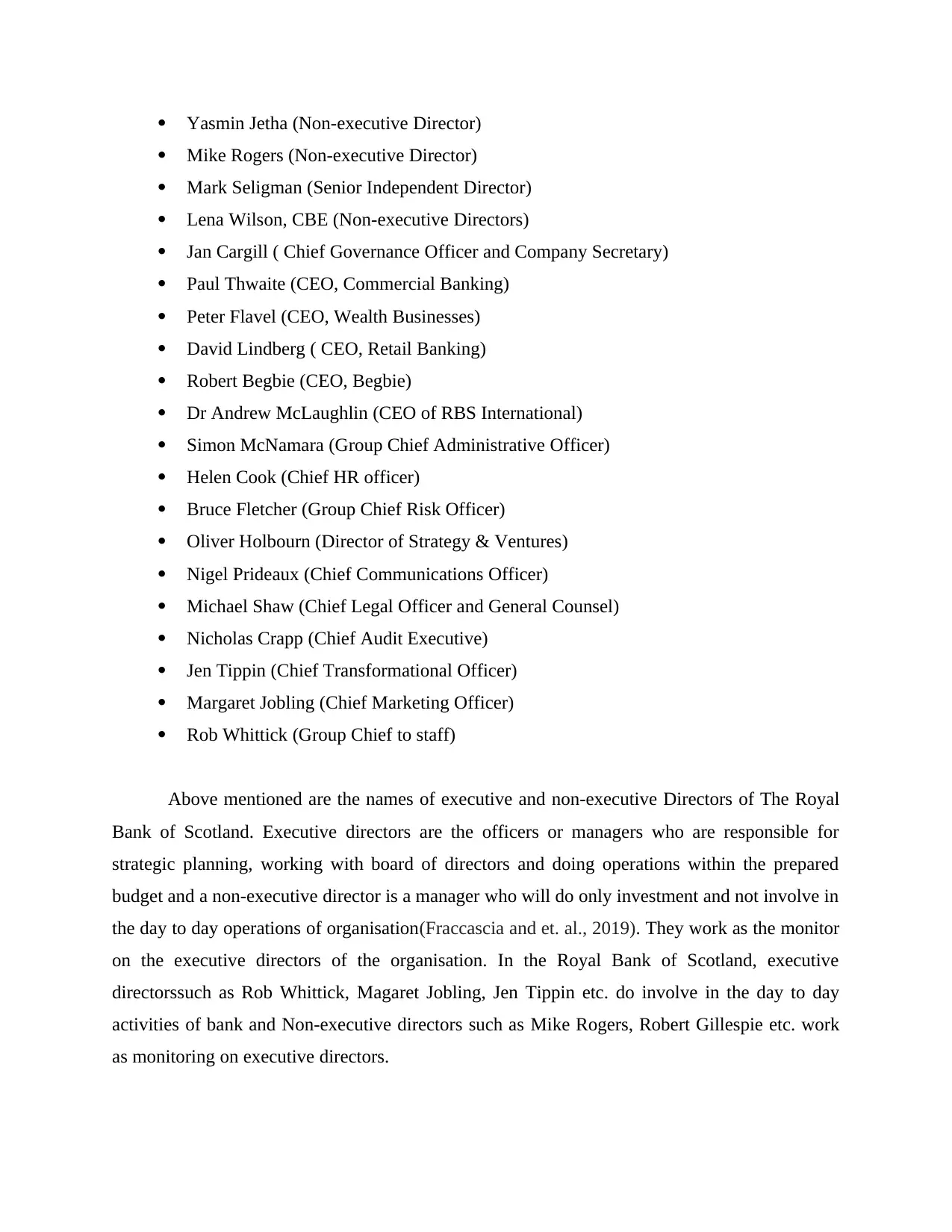
Yasmin Jetha (Non-executive Director)
Mike Rogers (Non-executive Director)
Mark Seligman (Senior Independent Director)
Lena Wilson, CBE (Non-executive Directors)
Jan Cargill ( Chief Governance Officer and Company Secretary)
Paul Thwaite (CEO, Commercial Banking)
Peter Flavel (CEO, Wealth Businesses)
David Lindberg ( CEO, Retail Banking)
Robert Begbie (CEO, Begbie)
Dr Andrew McLaughlin (CEO of RBS International)
Simon McNamara (Group Chief Administrative Officer)
Helen Cook (Chief HR officer)
Bruce Fletcher (Group Chief Risk Officer)
Oliver Holbourn (Director of Strategy & Ventures)
Nigel Prideaux (Chief Communications Officer)
Michael Shaw (Chief Legal Officer and General Counsel)
Nicholas Crapp (Chief Audit Executive)
Jen Tippin (Chief Transformational Officer)
Margaret Jobling (Chief Marketing Officer)
Rob Whittick (Group Chief to staff)
Above mentioned are the names of executive and non-executive Directors of The Royal
Bank of Scotland. Executive directors are the officers or managers who are responsible for
strategic planning, working with board of directors and doing operations within the prepared
budget and a non-executive director is a manager who will do only investment and not involve in
the day to day operations of organisation(Fraccascia and et. al., 2019). They work as the monitor
on the executive directors of the organisation. In the Royal Bank of Scotland, executive
directorssuch as Rob Whittick, Magaret Jobling, Jen Tippin etc. do involve in the day to day
activities of bank and Non-executive directors such as Mike Rogers, Robert Gillespie etc. work
as monitoring on executive directors.
Mike Rogers (Non-executive Director)
Mark Seligman (Senior Independent Director)
Lena Wilson, CBE (Non-executive Directors)
Jan Cargill ( Chief Governance Officer and Company Secretary)
Paul Thwaite (CEO, Commercial Banking)
Peter Flavel (CEO, Wealth Businesses)
David Lindberg ( CEO, Retail Banking)
Robert Begbie (CEO, Begbie)
Dr Andrew McLaughlin (CEO of RBS International)
Simon McNamara (Group Chief Administrative Officer)
Helen Cook (Chief HR officer)
Bruce Fletcher (Group Chief Risk Officer)
Oliver Holbourn (Director of Strategy & Ventures)
Nigel Prideaux (Chief Communications Officer)
Michael Shaw (Chief Legal Officer and General Counsel)
Nicholas Crapp (Chief Audit Executive)
Jen Tippin (Chief Transformational Officer)
Margaret Jobling (Chief Marketing Officer)
Rob Whittick (Group Chief to staff)
Above mentioned are the names of executive and non-executive Directors of The Royal
Bank of Scotland. Executive directors are the officers or managers who are responsible for
strategic planning, working with board of directors and doing operations within the prepared
budget and a non-executive director is a manager who will do only investment and not involve in
the day to day operations of organisation(Fraccascia and et. al., 2019). They work as the monitor
on the executive directors of the organisation. In the Royal Bank of Scotland, executive
directorssuch as Rob Whittick, Magaret Jobling, Jen Tippin etc. do involve in the day to day
activities of bank and Non-executive directors such as Mike Rogers, Robert Gillespie etc. work
as monitoring on executive directors.
⊘ This is a preview!⊘
Do you want full access?
Subscribe today to unlock all pages.

Trusted by 1+ million students worldwide
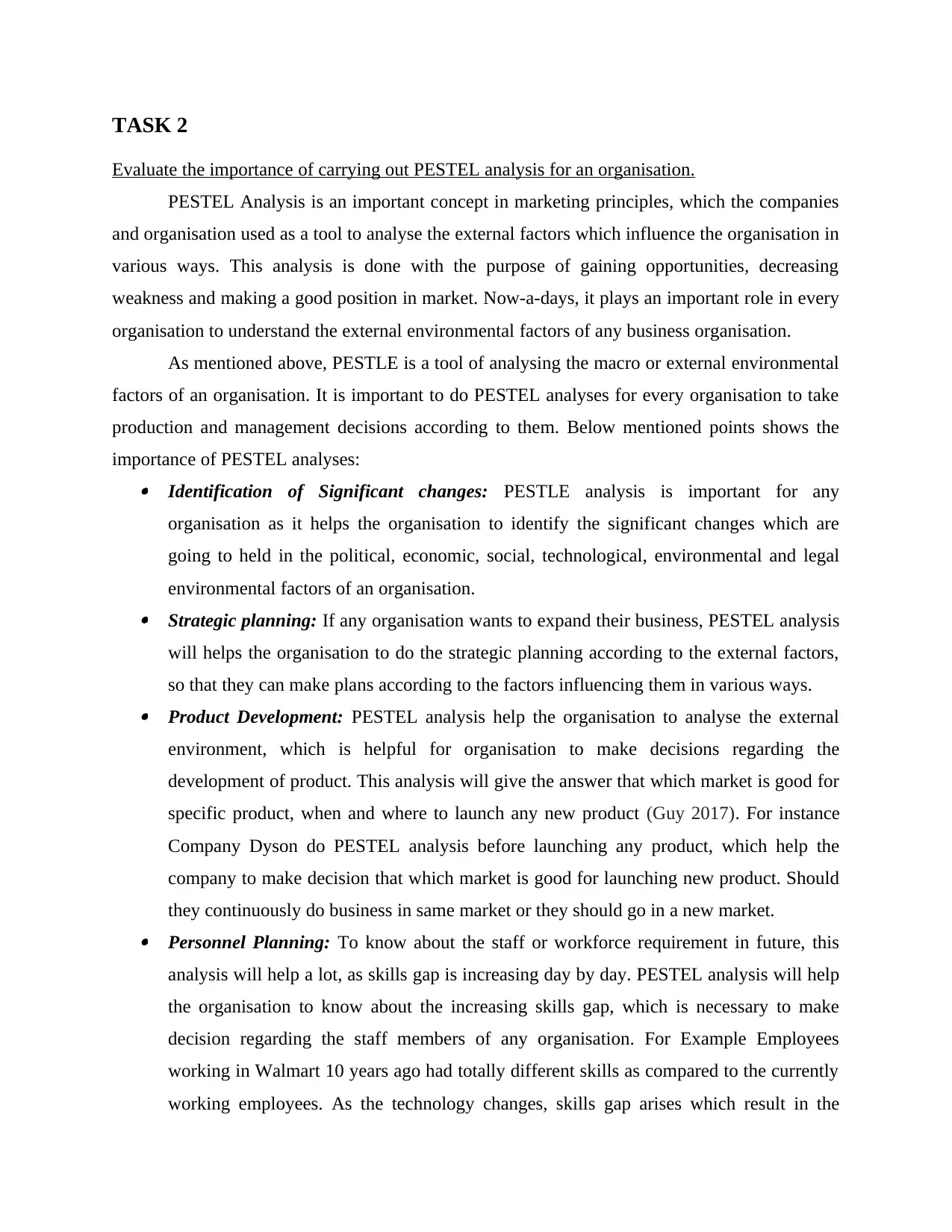
TASK 2
Evaluate the importance of carrying out PESTEL analysis for an organisation.
PESTEL Analysis is an important concept in marketing principles, which the companies
and organisation used as a tool to analyse the external factors which influence the organisation in
various ways. This analysis is done with the purpose of gaining opportunities, decreasing
weakness and making a good position in market. Now-a-days, it plays an important role in every
organisation to understand the external environmental factors of any business organisation.
As mentioned above, PESTLE is a tool of analysing the macro or external environmental
factors of an organisation. It is important to do PESTEL analyses for every organisation to take
production and management decisions according to them. Below mentioned points shows the
importance of PESTEL analyses: Identification of Significant changes: PESTLE analysis is important for any
organisation as it helps the organisation to identify the significant changes which are
going to held in the political, economic, social, technological, environmental and legal
environmental factors of an organisation. Strategic planning: If any organisation wants to expand their business, PESTEL analysis
will helps the organisation to do the strategic planning according to the external factors,
so that they can make plans according to the factors influencing them in various ways. Product Development: PESTEL analysis help the organisation to analyse the external
environment, which is helpful for organisation to make decisions regarding the
development of product. This analysis will give the answer that which market is good for
specific product, when and where to launch any new product (Guy 2017). For instance
Company Dyson do PESTEL analysis before launching any product, which help the
company to make decision that which market is good for launching new product. Should
they continuously do business in same market or they should go in a new market. Personnel Planning: To know about the staff or workforce requirement in future, this
analysis will help a lot, as skills gap is increasing day by day. PESTEL analysis will help
the organisation to know about the increasing skills gap, which is necessary to make
decision regarding the staff members of any organisation. For Example Employees
working in Walmart 10 years ago had totally different skills as compared to the currently
working employees. As the technology changes, skills gap arises which result in the
Evaluate the importance of carrying out PESTEL analysis for an organisation.
PESTEL Analysis is an important concept in marketing principles, which the companies
and organisation used as a tool to analyse the external factors which influence the organisation in
various ways. This analysis is done with the purpose of gaining opportunities, decreasing
weakness and making a good position in market. Now-a-days, it plays an important role in every
organisation to understand the external environmental factors of any business organisation.
As mentioned above, PESTLE is a tool of analysing the macro or external environmental
factors of an organisation. It is important to do PESTEL analyses for every organisation to take
production and management decisions according to them. Below mentioned points shows the
importance of PESTEL analyses: Identification of Significant changes: PESTLE analysis is important for any
organisation as it helps the organisation to identify the significant changes which are
going to held in the political, economic, social, technological, environmental and legal
environmental factors of an organisation. Strategic planning: If any organisation wants to expand their business, PESTEL analysis
will helps the organisation to do the strategic planning according to the external factors,
so that they can make plans according to the factors influencing them in various ways. Product Development: PESTEL analysis help the organisation to analyse the external
environment, which is helpful for organisation to make decisions regarding the
development of product. This analysis will give the answer that which market is good for
specific product, when and where to launch any new product (Guy 2017). For instance
Company Dyson do PESTEL analysis before launching any product, which help the
company to make decision that which market is good for launching new product. Should
they continuously do business in same market or they should go in a new market. Personnel Planning: To know about the staff or workforce requirement in future, this
analysis will help a lot, as skills gap is increasing day by day. PESTEL analysis will help
the organisation to know about the increasing skills gap, which is necessary to make
decision regarding the staff members of any organisation. For Example Employees
working in Walmart 10 years ago had totally different skills as compared to the currently
working employees. As the technology changes, skills gap arises which result in the
Paraphrase This Document
Need a fresh take? Get an instant paraphrase of this document with our AI Paraphraser
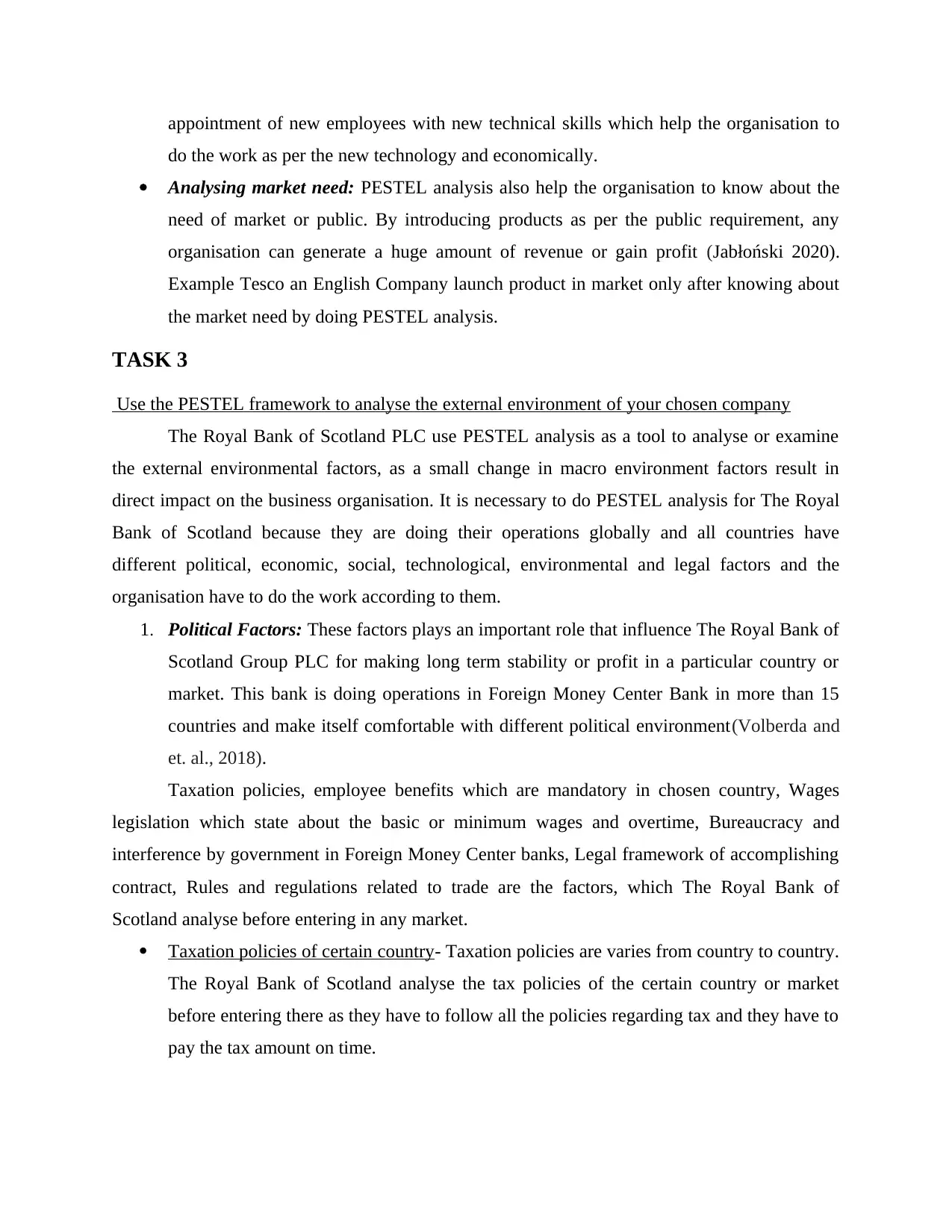
appointment of new employees with new technical skills which help the organisation to
do the work as per the new technology and economically.
Analysing market need: PESTEL analysis also help the organisation to know about the
need of market or public. By introducing products as per the public requirement, any
organisation can generate a huge amount of revenue or gain profit (Jabłoński 2020).
Example Tesco an English Company launch product in market only after knowing about
the market need by doing PESTEL analysis.
TASK 3
Use the PESTEL framework to analyse the external environment of your chosen company
The Royal Bank of Scotland PLC use PESTEL analysis as a tool to analyse or examine
the external environmental factors, as a small change in macro environment factors result in
direct impact on the business organisation. It is necessary to do PESTEL analysis for The Royal
Bank of Scotland because they are doing their operations globally and all countries have
different political, economic, social, technological, environmental and legal factors and the
organisation have to do the work according to them.
1. Political Factors: These factors plays an important role that influence The Royal Bank of
Scotland Group PLC for making long term stability or profit in a particular country or
market. This bank is doing operations in Foreign Money Center Bank in more than 15
countries and make itself comfortable with different political environment(Volberda and
et. al., 2018).
Taxation policies, employee benefits which are mandatory in chosen country, Wages
legislation which state about the basic or minimum wages and overtime, Bureaucracy and
interference by government in Foreign Money Center banks, Legal framework of accomplishing
contract, Rules and regulations related to trade are the factors, which The Royal Bank of
Scotland analyse before entering in any market.
Taxation policies of certain country- Taxation policies are varies from country to country.
The Royal Bank of Scotland analyse the tax policies of the certain country or market
before entering there as they have to follow all the policies regarding tax and they have to
pay the tax amount on time.
do the work as per the new technology and economically.
Analysing market need: PESTEL analysis also help the organisation to know about the
need of market or public. By introducing products as per the public requirement, any
organisation can generate a huge amount of revenue or gain profit (Jabłoński 2020).
Example Tesco an English Company launch product in market only after knowing about
the market need by doing PESTEL analysis.
TASK 3
Use the PESTEL framework to analyse the external environment of your chosen company
The Royal Bank of Scotland PLC use PESTEL analysis as a tool to analyse or examine
the external environmental factors, as a small change in macro environment factors result in
direct impact on the business organisation. It is necessary to do PESTEL analysis for The Royal
Bank of Scotland because they are doing their operations globally and all countries have
different political, economic, social, technological, environmental and legal factors and the
organisation have to do the work according to them.
1. Political Factors: These factors plays an important role that influence The Royal Bank of
Scotland Group PLC for making long term stability or profit in a particular country or
market. This bank is doing operations in Foreign Money Center Bank in more than 15
countries and make itself comfortable with different political environment(Volberda and
et. al., 2018).
Taxation policies, employee benefits which are mandatory in chosen country, Wages
legislation which state about the basic or minimum wages and overtime, Bureaucracy and
interference by government in Foreign Money Center banks, Legal framework of accomplishing
contract, Rules and regulations related to trade are the factors, which The Royal Bank of
Scotland analyse before entering in any market.
Taxation policies of certain country- Taxation policies are varies from country to country.
The Royal Bank of Scotland analyse the tax policies of the certain country or market
before entering there as they have to follow all the policies regarding tax and they have to
pay the tax amount on time.
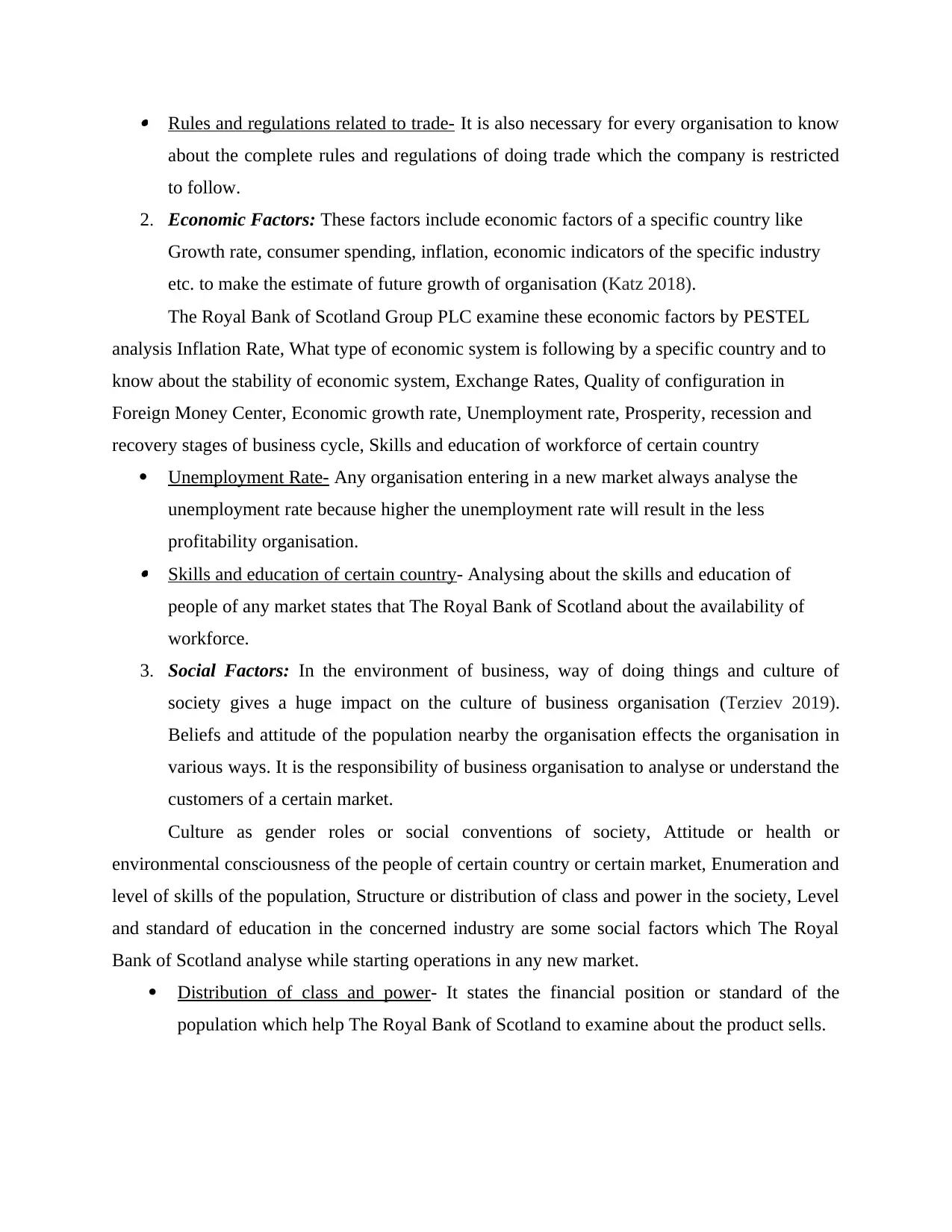
Rules and regulations related to trade- It is also necessary for every organisation to know
about the complete rules and regulations of doing trade which the company is restricted
to follow.
2. Economic Factors: These factors include economic factors of a specific country like
Growth rate, consumer spending, inflation, economic indicators of the specific industry
etc. to make the estimate of future growth of organisation (Katz 2018).
The Royal Bank of Scotland Group PLC examine these economic factors by PESTEL
analysis Inflation Rate, What type of economic system is following by a specific country and to
know about the stability of economic system, Exchange Rates, Quality of configuration in
Foreign Money Center, Economic growth rate, Unemployment rate, Prosperity, recession and
recovery stages of business cycle, Skills and education of workforce of certain country
Unemployment Rate- Any organisation entering in a new market always analyse the
unemployment rate because higher the unemployment rate will result in the less
profitability organisation. Skills and education of certain country- Analysing about the skills and education of
people of any market states that The Royal Bank of Scotland about the availability of
workforce.
3. Social Factors: In the environment of business, way of doing things and culture of
society gives a huge impact on the culture of business organisation (Terziev 2019).
Beliefs and attitude of the population nearby the organisation effects the organisation in
various ways. It is the responsibility of business organisation to analyse or understand the
customers of a certain market.
Culture as gender roles or social conventions of society, Attitude or health or
environmental consciousness of the people of certain country or certain market, Enumeration and
level of skills of the population, Structure or distribution of class and power in the society, Level
and standard of education in the concerned industry are some social factors which The Royal
Bank of Scotland analyse while starting operations in any new market.
Distribution of class and power- It states the financial position or standard of the
population which help The Royal Bank of Scotland to examine about the product sells.
about the complete rules and regulations of doing trade which the company is restricted
to follow.
2. Economic Factors: These factors include economic factors of a specific country like
Growth rate, consumer spending, inflation, economic indicators of the specific industry
etc. to make the estimate of future growth of organisation (Katz 2018).
The Royal Bank of Scotland Group PLC examine these economic factors by PESTEL
analysis Inflation Rate, What type of economic system is following by a specific country and to
know about the stability of economic system, Exchange Rates, Quality of configuration in
Foreign Money Center, Economic growth rate, Unemployment rate, Prosperity, recession and
recovery stages of business cycle, Skills and education of workforce of certain country
Unemployment Rate- Any organisation entering in a new market always analyse the
unemployment rate because higher the unemployment rate will result in the less
profitability organisation. Skills and education of certain country- Analysing about the skills and education of
people of any market states that The Royal Bank of Scotland about the availability of
workforce.
3. Social Factors: In the environment of business, way of doing things and culture of
society gives a huge impact on the culture of business organisation (Terziev 2019).
Beliefs and attitude of the population nearby the organisation effects the organisation in
various ways. It is the responsibility of business organisation to analyse or understand the
customers of a certain market.
Culture as gender roles or social conventions of society, Attitude or health or
environmental consciousness of the people of certain country or certain market, Enumeration and
level of skills of the population, Structure or distribution of class and power in the society, Level
and standard of education in the concerned industry are some social factors which The Royal
Bank of Scotland analyse while starting operations in any new market.
Distribution of class and power- It states the financial position or standard of the
population which help The Royal Bank of Scotland to examine about the product sells.
⊘ This is a preview!⊘
Do you want full access?
Subscribe today to unlock all pages.

Trusted by 1+ million students worldwide
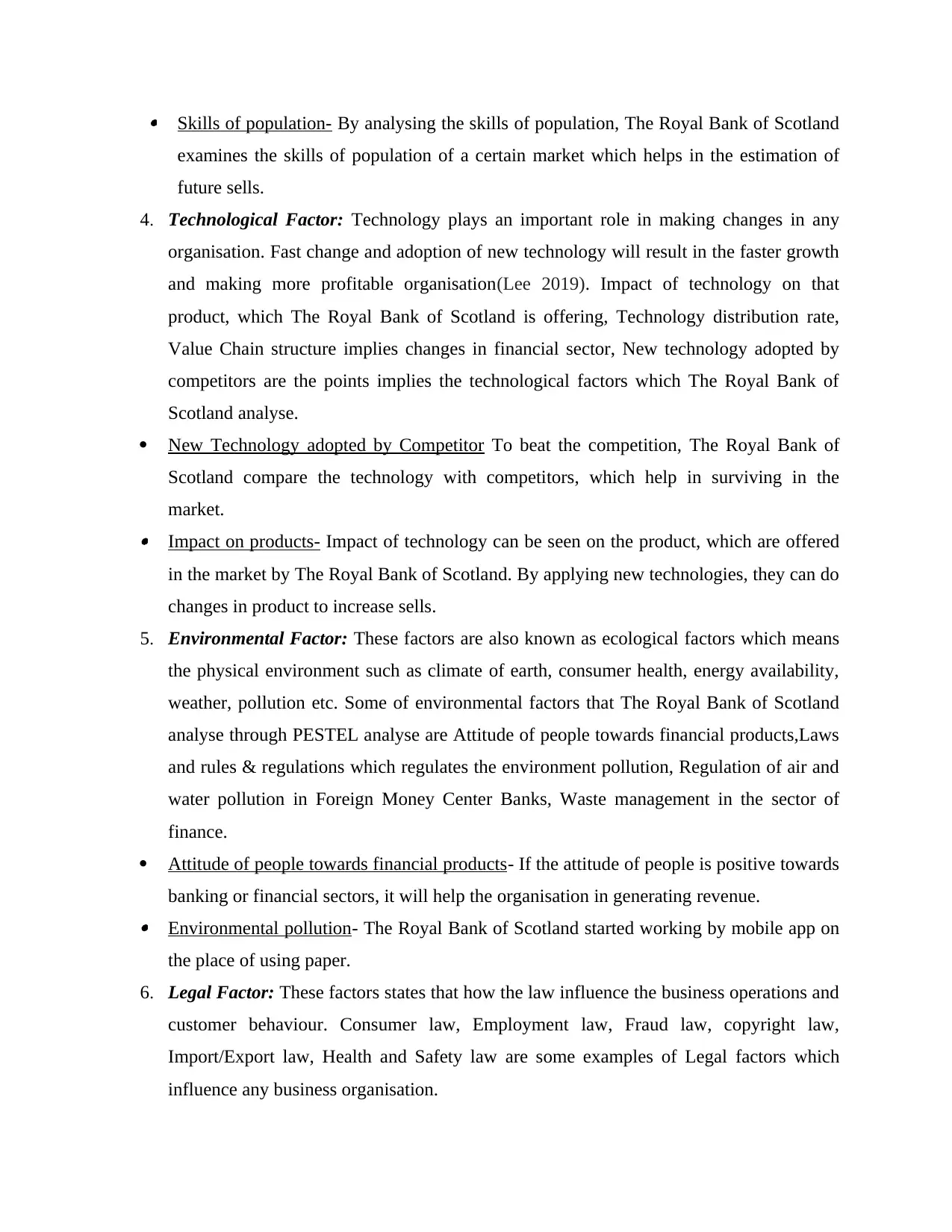
Skills of population- By analysing the skills of population, The Royal Bank of Scotland
examines the skills of population of a certain market which helps in the estimation of
future sells.
4. Technological Factor: Technology plays an important role in making changes in any
organisation. Fast change and adoption of new technology will result in the faster growth
and making more profitable organisation(Lee 2019). Impact of technology on that
product, which The Royal Bank of Scotland is offering, Technology distribution rate,
Value Chain structure implies changes in financial sector, New technology adopted by
competitors are the points implies the technological factors which The Royal Bank of
Scotland analyse.
New Technology adopted by Competitor To beat the competition, The Royal Bank of
Scotland compare the technology with competitors, which help in surviving in the
market. Impact on products- Impact of technology can be seen on the product, which are offered
in the market by The Royal Bank of Scotland. By applying new technologies, they can do
changes in product to increase sells.
5. Environmental Factor: These factors are also known as ecological factors which means
the physical environment such as climate of earth, consumer health, energy availability,
weather, pollution etc. Some of environmental factors that The Royal Bank of Scotland
analyse through PESTEL analyse are Attitude of people towards financial products,Laws
and rules & regulations which regulates the environment pollution, Regulation of air and
water pollution in Foreign Money Center Banks, Waste management in the sector of
finance.
Attitude of people towards financial products- If the attitude of people is positive towards
banking or financial sectors, it will help the organisation in generating revenue. Environmental pollution- The Royal Bank of Scotland started working by mobile app on
the place of using paper.
6. Legal Factor: These factors states that how the law influence the business operations and
customer behaviour. Consumer law, Employment law, Fraud law, copyright law,
Import/Export law, Health and Safety law are some examples of Legal factors which
influence any business organisation.
examines the skills of population of a certain market which helps in the estimation of
future sells.
4. Technological Factor: Technology plays an important role in making changes in any
organisation. Fast change and adoption of new technology will result in the faster growth
and making more profitable organisation(Lee 2019). Impact of technology on that
product, which The Royal Bank of Scotland is offering, Technology distribution rate,
Value Chain structure implies changes in financial sector, New technology adopted by
competitors are the points implies the technological factors which The Royal Bank of
Scotland analyse.
New Technology adopted by Competitor To beat the competition, The Royal Bank of
Scotland compare the technology with competitors, which help in surviving in the
market. Impact on products- Impact of technology can be seen on the product, which are offered
in the market by The Royal Bank of Scotland. By applying new technologies, they can do
changes in product to increase sells.
5. Environmental Factor: These factors are also known as ecological factors which means
the physical environment such as climate of earth, consumer health, energy availability,
weather, pollution etc. Some of environmental factors that The Royal Bank of Scotland
analyse through PESTEL analyse are Attitude of people towards financial products,Laws
and rules & regulations which regulates the environment pollution, Regulation of air and
water pollution in Foreign Money Center Banks, Waste management in the sector of
finance.
Attitude of people towards financial products- If the attitude of people is positive towards
banking or financial sectors, it will help the organisation in generating revenue. Environmental pollution- The Royal Bank of Scotland started working by mobile app on
the place of using paper.
6. Legal Factor: These factors states that how the law influence the business operations and
customer behaviour. Consumer law, Employment law, Fraud law, copyright law,
Import/Export law, Health and Safety law are some examples of Legal factors which
influence any business organisation.
Paraphrase This Document
Need a fresh take? Get an instant paraphrase of this document with our AI Paraphraser

Health & Safety law, Employment law, Data protection, Anti-trust law in Foreign Money
Center Banks Industry and overall in the country, Intellectual Property law, Consumer law,Fraud
law are legal factors influencing the bank.
Employment law- The Royal Bank of Scotland have to follow the employment law, that
they have to provide employment to that country in which they are going to start
operations(Rendtorff 2017).
Fraud Law- It means the bank is not allowed to do fraud with any customer, if the bank
do the same, The government of certain country have right to punish them.
CONCLUSION
From the above report, it is concluded that Business Environment plays an important role
in doing operations in any business organisation. Analysing of both internal (micro) as well as
external (macro) business environment are mandatory to gain opportunities and remove
weakness and threats. It is important for that organisation which is going to enter in a new
market to analyse all the aspects of external environment to perform their operations without
facing any problem. Furthermore, it is analysed that The Royal bank of Scotland to PESTLE
analyse before entering in a new market or country which helps them to understand about the
factor which are going to influence them in day to day activity.
Center Banks Industry and overall in the country, Intellectual Property law, Consumer law,Fraud
law are legal factors influencing the bank.
Employment law- The Royal Bank of Scotland have to follow the employment law, that
they have to provide employment to that country in which they are going to start
operations(Rendtorff 2017).
Fraud Law- It means the bank is not allowed to do fraud with any customer, if the bank
do the same, The government of certain country have right to punish them.
CONCLUSION
From the above report, it is concluded that Business Environment plays an important role
in doing operations in any business organisation. Analysing of both internal (micro) as well as
external (macro) business environment are mandatory to gain opportunities and remove
weakness and threats. It is important for that organisation which is going to enter in a new
market to analyse all the aspects of external environment to perform their operations without
facing any problem. Furthermore, it is analysed that The Royal bank of Scotland to PESTLE
analyse before entering in a new market or country which helps them to understand about the
factor which are going to influence them in day to day activity.
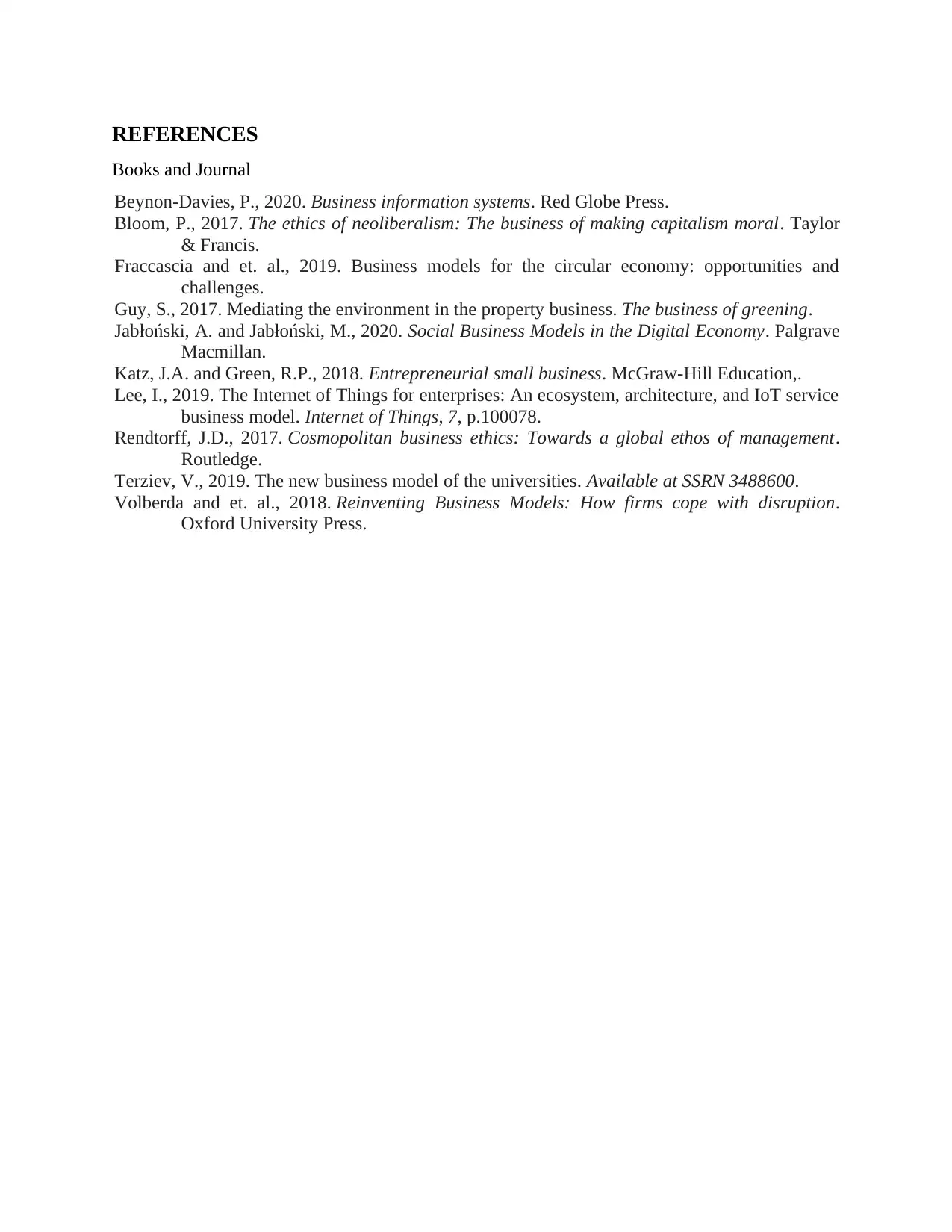
REFERENCES
Books and Journal
Beynon-Davies, P., 2020. Business information systems. Red Globe Press.
Bloom, P., 2017. The ethics of neoliberalism: The business of making capitalism moral. Taylor
& Francis.
Fraccascia and et. al., 2019. Business models for the circular economy: opportunities and
challenges.
Guy, S., 2017. Mediating the environment in the property business. The business of greening.
Jabłoński, A. and Jabłoński, M., 2020. Social Business Models in the Digital Economy. Palgrave
Macmillan.
Katz, J.A. and Green, R.P., 2018. Entrepreneurial small business. McGraw-Hill Education,.
Lee, I., 2019. The Internet of Things for enterprises: An ecosystem, architecture, and IoT service
business model. Internet of Things, 7, p.100078.
Rendtorff, J.D., 2017. Cosmopolitan business ethics: Towards a global ethos of management.
Routledge.
Terziev, V., 2019. The new business model of the universities. Available at SSRN 3488600.
Volberda and et. al., 2018. Reinventing Business Models: How firms cope with disruption.
Oxford University Press.
Books and Journal
Beynon-Davies, P., 2020. Business information systems. Red Globe Press.
Bloom, P., 2017. The ethics of neoliberalism: The business of making capitalism moral. Taylor
& Francis.
Fraccascia and et. al., 2019. Business models for the circular economy: opportunities and
challenges.
Guy, S., 2017. Mediating the environment in the property business. The business of greening.
Jabłoński, A. and Jabłoński, M., 2020. Social Business Models in the Digital Economy. Palgrave
Macmillan.
Katz, J.A. and Green, R.P., 2018. Entrepreneurial small business. McGraw-Hill Education,.
Lee, I., 2019. The Internet of Things for enterprises: An ecosystem, architecture, and IoT service
business model. Internet of Things, 7, p.100078.
Rendtorff, J.D., 2017. Cosmopolitan business ethics: Towards a global ethos of management.
Routledge.
Terziev, V., 2019. The new business model of the universities. Available at SSRN 3488600.
Volberda and et. al., 2018. Reinventing Business Models: How firms cope with disruption.
Oxford University Press.
⊘ This is a preview!⊘
Do you want full access?
Subscribe today to unlock all pages.

Trusted by 1+ million students worldwide
1 out of 12
Related Documents
Your All-in-One AI-Powered Toolkit for Academic Success.
+13062052269
info@desklib.com
Available 24*7 on WhatsApp / Email
![[object Object]](/_next/static/media/star-bottom.7253800d.svg)
Unlock your academic potential
Copyright © 2020–2026 A2Z Services. All Rights Reserved. Developed and managed by ZUCOL.





